

Untitled Document. Theoretical physicists rarely achieve the status of rock stars, but Argentina's Juan Maldacena, 30, may be an exception.
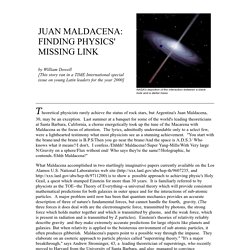
Last summer at a banquet for some of the world's leading theoreticians at Santa Barbara, California, a chorus energetically took up the tune of the Macarena with Maldacena as the focus of attention. The lyrics, admittedly understandable only to a select few, were a lighthearted testimony what most physicists see as a stunning achievement. "You start with the brane/and the brane is B.P.S/Then you go near the brane/And the space is A.D.S.3/ Who knows what it means? Top 10 most beautiful (minds) It’s very important to put things in order, right?

Because otherwise, how would you know which is the number 1 most popular song on iTunes, so you can look cool by buying it too? Or how would you know who is Who Weekly’s most beautiful person in the world, so you can work your way down the list, being rejected by each of them in turn? Or how would you know who is New Zealand’s Next Top Model? Following this lofty tradition, today we’re going to rank the world’s best physicists. And to do that, we’ll use an algorithm devised by Johannes Koelman, the Hammock Physicist. To calculate the Einstein Index all you do is add up the number of citations for each scientist’s top 3 papers, and that total is their Einstein index. Sean Carroll: Lecture Notes on General Relativity. These lecture notes are a lightly edited version of the ones I handed out while teaching Physics 8.962, the graduate course in General Relativity at MIT, during Spring 1996.
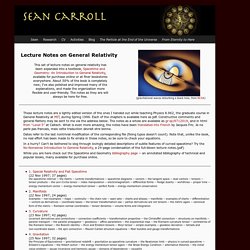
Each of the chapters is available here as pdf. Constructive comments and general flattery may be sent to me via the address below. The notes as a whole are available as gr-qc/9712019, and in html from "Level 5" at Caltech. What is even more amazing, the notes have been translated into French by Jacques Fric. Je ne parle pas francais, mais cette traduction devrait etre bonne. Dates refer to the last nontrivial modification of the corresponding file (fixing typos doesn't count). In a hurry? While you are here check out the Spacetime and Geometry bibliography page -- an annotated bibilography of technical and popular books, many available for purchase online.
A Physics Booklist. [Physics FAQ] - [Copyright] Updated 2005.

Updated 1994—1997 by SIC, PEG. Original by Vijay Fafat. This article is a compilation of books recommended by sci.physics participants as the "standard" or "classic" texts on a wide variety of topics of general interest to physicists and physics students. As a guide to finding the right book for you, many of the comments from the contributors have been retained. Some entries here are incomplete, and many good books are not yet listed. Details such as publisher, date and ISBN numbers below are far and few between. If you are looking for a book that is out of print, try: Subject Index General Physics (so even mathematicians can understand it!) Course Catalogue. PX436 notes. I will put PDF files of my lecture notes (i.e. those I use in lectures) here.
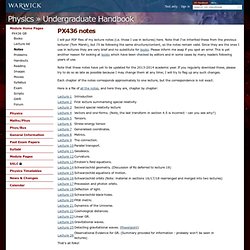
Note that I've inherited these from the previous lecturer (Tom Marsh), but I'll be following the same structure/content, so the notes remain valid. Since they are the ones I use in lectures they are very brief and no substitute for books. Please inform me asap if you spot an error. This is yet another reason for looking at books which have been checked by editors and in some cases by many readers following years of use. Note that these notes have yet to be updated for the 2013-2014 academic year. Each chapter of the notes corresponds approximately to one lecture, but the correspondence is not exact. Here is a file of all the notes, and here they are, chapter by chapter: D’Inverno – Introducing Einstein’s Relativity problems. Here are my solutions to various problems in Ray D’Inverno’s textbook Introducing Einstein’s Relativity.
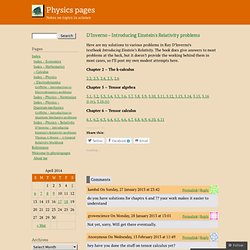
The book does give answers to most problems at the back, but it doesn’t provide the working behind them in most cases, so I’ll post my own modest attempts here. Chapter 2 – The k-calculus Chapter 5 – Tensor algebra. A Guide to Relativity Books. [Physics FAQ] - [Copyright] Original by Chris Hillman (with contributions by Nathan Urban) September 1998.
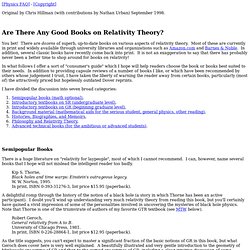
You bet! There are dozens of superb, up-to-date books on various aspects of relativity theory. Most of these are currently in print and widely available through university libraries and organizations such as Amazon.com and Barnes & Noble. In addition, several classic books have recently come back into print. In what follows I offer a sort of "consumer's guide" which I hope will help readers choose the book or books best suited to their needs. I have divided the discussion into seven broad categories: The Theoretical Minimum. Carroll notes on general relativity. Warp Field Mechanics 101.
Relativity. DrPhysicsA. BlackBodyRad. Introduction to tensors. HyperPhysics. Quantum Chemistry 19-386 Tutorials.